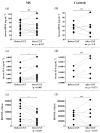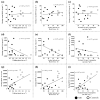Fitness Shifts the Balance of BDNF and IL-6 from Inflammation to Repair among People with Progressive Multiple Sclerosis
- PMID: 33810574
- PMCID: PMC8066063
- DOI: 10.3390/biom11040504
Fitness Shifts the Balance of BDNF and IL-6 from Inflammation to Repair among People with Progressive Multiple Sclerosis
Abstract
Physical sedentarism is linked to elevated levels of circulating cytokines, whereas exercise upregulates growth-promoting proteins such as brain-derived neurotrophic factor (BDNF). The shift towards a 'repair' phenotype could protect against neurodegeneration, especially in diseases such as multiple sclerosis (MS). We investigated whether having higher fitness or participating in an acute bout of maximal exercise would shift the balance of BDNF and interleukin-6 (IL-6) in serum samples of people with progressive MS (n = 14), compared to matched controls (n = 8). Participants performed a maximal graded exercise test on a recumbent stepper, and blood samples were collected at rest and after the test. We assessed walking speed, fatigue, and maximal oxygen consumption (V·O2max). People with MS achieved about 50% lower V·O2max (p = 0.003) than controls. At rest, there were no differences in BDNF between MS and controls; however, IL-6 was significantly higher in MS. Higher V·O2max was associated with a shift in BDNF/IL-6 ratio from inflammation to repair (R = 0.7, p = 0.001) when considering both groups together. In the MS group, greater ability to upregulate BDNF was associated with faster walking speed and lower vitality. We present evidence that higher fitness indicates a shift in the balance of blood biomarkers towards a repair phenotype in progressive MS.
Keywords: biomarkers; brain-derived neurotrophic factor; cytokines; fitness; inflammation; interleukin-6; multiple sclerosis; neurodegeneration; neurotrophins; rehabilitation.
Conflict of interest statement
The authors declare no conflict of interest. The funders had no role in the design of the study; in the collection, analyses, or interpretation of data; in the writing of the manuscript, or in the decision to publish the results.
Figures



Similar articles
-
Effects of exercise on Irisin, BDNF and IL-6 serum levels in patients with progressive multiple sclerosis.J Neuroimmunol. 2016 Oct 15;299:53-58. doi: 10.1016/j.jneuroim.2016.08.007. Epub 2016 Aug 5. J Neuroimmunol. 2016. PMID: 27725121 Clinical Trial.
-
The Association Between Myokines, Inflammation, and Nutritional Status in Patients with Multiple Sclerosis.Biomolecules. 2025 May 12;15(5):703. doi: 10.3390/biom15050703. Biomolecules. 2025. PMID: 40427596 Free PMC article.
-
Strength training reduces circulating interleukin-6 but not brain-derived neurotrophic factor in community-dwelling elderly individuals.Age (Dordr). 2014;36(5):9704. doi: 10.1007/s11357-014-9704-6. Epub 2014 Aug 16. Age (Dordr). 2014. PMID: 25128203 Free PMC article. Clinical Trial.
-
Immediate and short-term effect of physical exercise on BDNF in multiple sclerosis patients: a systematic review and meta-analysis.Sci Rep. 2025 Jun 4;15(1):19696. doi: 10.1038/s41598-025-04675-0. Sci Rep. 2025. PMID: 40467854 Free PMC article.
-
Dosage and Effectiveness of Aerobic Training on Cardiorespiratory Fitness, Functional Capacity, Balance, and Fatigue in People With Multiple Sclerosis: A Systematic Review and Meta-Analysis.Arch Phys Med Rehabil. 2021 Sep;102(9):1826-1839. doi: 10.1016/j.apmr.2021.01.078. Epub 2021 Feb 7. Arch Phys Med Rehabil. 2021. PMID: 33567335
Cited by
-
Exercise-induced increase in blood-based brain-derived neurotrophic factor (BDNF) in people with multiple sclerosis: A systematic review and meta-analysis of exercise intervention trials.PLoS One. 2022 Mar 3;17(3):e0264557. doi: 10.1371/journal.pone.0264557. eCollection 2022. PLoS One. 2022. PMID: 35239684 Free PMC article.
-
Cytokine Profile in Patients with Multiple Sclerosis Following Exercise: A Systematic Review of Randomized Clinical Trials.Int J Environ Res Public Health. 2022 Jul 2;19(13):8151. doi: 10.3390/ijerph19138151. Int J Environ Res Public Health. 2022. PMID: 35805808 Free PMC article.
-
Effects of Mind-Body Interventions on Immune and Neuroendocrine Functions: A Systematic Review and Meta-Analysis of Randomized Controlled Trials.Healthcare (Basel). 2025 Apr 21;13(8):952. doi: 10.3390/healthcare13080952. Healthcare (Basel). 2025. PMID: 40281902 Free PMC article. Review.
-
Effects of aerobic exercise on demyelination and brain morphology in the cuprizone rat model of multiple sclerosis.Metab Brain Dis. 2024 Oct;39(7):1283-1290. doi: 10.1007/s11011-024-01377-w. Epub 2024 Sep 28. Metab Brain Dis. 2024. PMID: 39340612
-
The MoxFo initiative-Mechanisms of action: Biomarkers in multiple sclerosis exercise studies.Mult Scler. 2023 Nov;29(13):1569-1577. doi: 10.1177/13524585231204453. Epub 2023 Oct 26. Mult Scler. 2023. PMID: 37880953 Free PMC article.
References
Publication types
MeSH terms
Substances
Grants and funding
- Program of Experimental Medicine Graduate Scholarship
- Translational and Personalized Medicine Initiative (TPMI)/NL SUPPORT Educational Funding
- O'Dea Family Fellowship
- 5404.1699.104/Research and Development Corporation of Newfoundland and Labrador
- 230457/Canada Excellence Research Chairs, Government of Canada
LinkOut - more resources
Full Text Sources
Other Literature Sources
Medical

